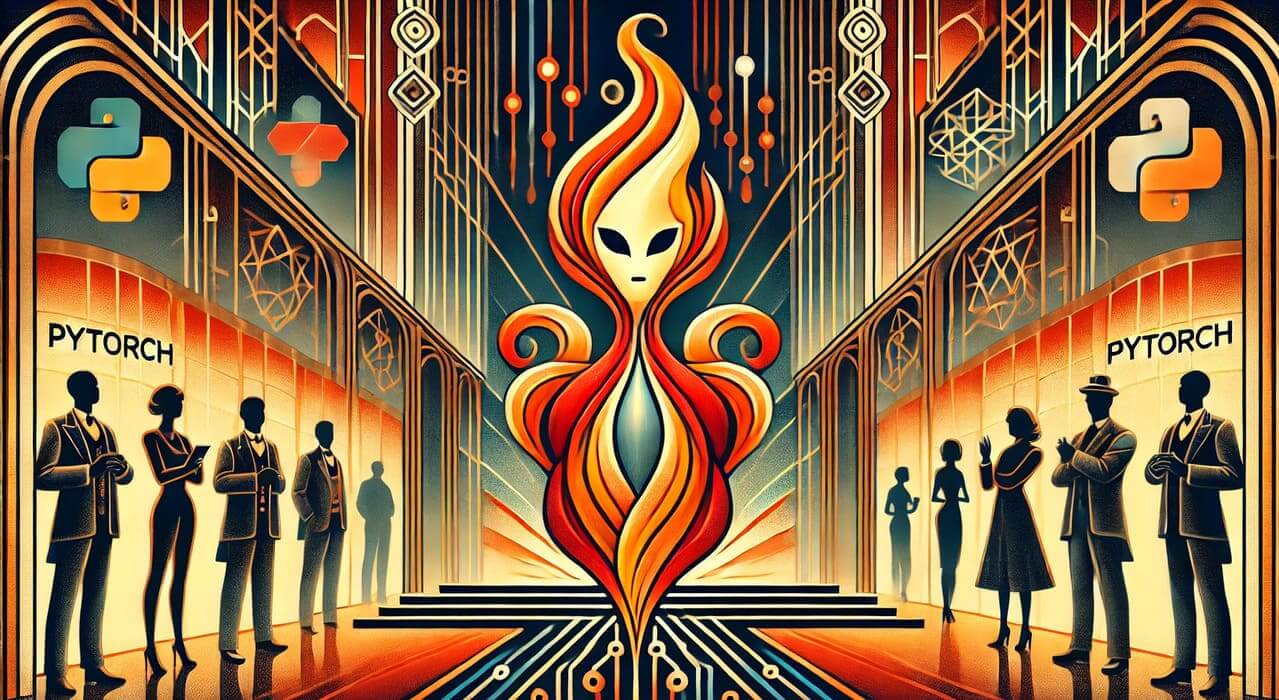It began quietly, like a whispered rumor in the digital corridors of research labs and startup incubators. For years, there was TensorFlow—a flashy luminary backed by one of the biggest names in tech. But as AI turned ever more ambitious, a challenger stepped from the shadows and seized the crown. That challenger is PyTorch, a framework that’s redefining machine learning with its disarming simplicity and breathtaking speed.
A Changing of the Guard in Machine Learning
They say artificial intelligence is the final frontier—an arms race for the future. Once, TensorFlow reigned supreme, its name etched into neural networks spanning everything from speech recognition to medical imaging. Yet the winds shifted. Researchers, developers, even entire companies pivoted to a new champion. And why? Because in a high-stakes world where code must be swift, flexible, and oh-so-readable, PyTorch emerged as the perfect mix of elegance and power (Paszke et al., 2019).
PyTorch’s Secret Ingredient: Speak Developer, Not Jargon
If there’s one quality that catapulted PyTorch to fame, it’s its uncanny knack for “speaking Python” in a way that feels alive. Gone are the days of wrestling with monolithic computation graphs that demand arcane debugging rituals. Instead, you get a fluid, dynamic environment—where you write code in near-real time, see results instantly, and adapt on the fly (Agrawal, Taqvi, & Gulati, 2024). Like an artist refining brushstrokes on a canvas, you can tweak, adjust, and sculpt your model without rewriting half your script. It’s a developer’s dream.
Big Wins That Redefined the Game
- Dynamic Computation Graphs: Picture a dance floor where the choreography changes every beat. PyTorch’s dynamic graphs mean you’re never tied to a single routine. It’s all about improvisation and quick iteration.
- Seamless GPU Acceleration: In a world where speed can make or break a product demo, PyTorch flips from CPU to GPU with a single line. No backflips. No tributes to the software gods.
- Pythonic Syntax: It’s almost too easy. You can build a robust deep learning pipeline in the same style as standard Python, weaving in your logic naturally—like you’re writing everyday scripts.
PyTorch vs. TensorFlow: Clash of the Titans
Let’s not kid ourselves—TensorFlow was an empire. Generously funded, heavily documented, crowned by Google’s might. But as machine learning research soared, its rigidity weighed it down. Enter PyTorch, with an enticing promise of real-time model modification and a debugging process that actually makes sense (Agrawal et al., 2024). Suddenly, the emperor looked less invincible.
- Flexibility: Real-time edits? Check. TensorFlow’s static graphs became a headache for the inquisitive mind.
- Community: PyTorch’s open arms quickly gathered a global chorus of researchers. With Meta AI as one of its star backers, collaboration soared to new heights.
- Industry Adoption: What started in academia soon spilled over to tech giants. Today, from self-driving cars to next-level chatbots, PyTorch powers the frontier.
The New Chapter: PyTorch 2.0 and Beyond
They said PyTorch was already a marvel—then 2.0 arrived, leveling up the game. Two brilliant additions stand out:
- TorchDynamo: A stealthy compiler that accelerates inference without sacrificing user-friendly coding (Ansel et al., 2024).
- TorchInductor: A behind-the-scenes mastermind ensuring blistering speed across diverse hardware, from NVIDIA GPUs to other specialized accelerators.
The result? Eye-popping benchmarks. Think 2.27× faster inference and a 1.41× boost in training speeds. For machine learning devotees, it’s like shifting from a trusty sedan to a sleek sports car. Same route, half the travel time.
TorchRL: When AI Teaches Itself
If machine learning were a movie, reinforcement learning would be the high-octane action sequence. PyTorch’s TorchRL library is rewriting that script, giving developers the tools to craft agents that learn by doing (Bou et al., 2023). Think about it: self-driving cars. Automated trading bots. Robots that adapt to shifting factory floors. With TorchRL’s new TensorDict primitive, building and testing RL algorithms feels as sleek as PyTorch itself.
A Glimpse of Tomorrow
So here we stand, at the crossroads of AI’s next great leap. PyTorch isn’t a mere framework—it’s the glowing heart fueling modern AI. The language is intuitive, the speed is exhilarating, and the community pulses with the thrill of possibility. Whether you’re a research scientist daring to push boundaries or a startup founder searching for the edge, PyTorch sets the stage for big moves and bold dreams (Paszke et al., 2019).
And if PyTorch 2.0 signals anything, it’s that we’re only at the prologue. With revolutionary compilers and libraries sprouting across the ecosystem, the AI future looks more compelling than ever. The only question: are you ready to harness the speed, agility, and raw power that PyTorch brings to the table?
References
Agrawal, G., Taqvi, S., & Gulati, R. (2024). Machine Learning with TensorFlow and PyTorch: A Comparative Analysis. resmilitaris. https://doi.org/10.48047/resmil.v10i1.21.m.2024.015203
Ansel, J., Yang, E., He, H., Gimelshein, N., Jain, A., Voznesensky, M., Bao, B., Bell, P., Berard, D., Burovski, E., & Chintala, S. (2024). PyTorch 2: Faster machine learning through dynamic Python bytecode transformation and graph compilation. Proceedings of the 29th ACM International Conference on Architectural Support for Programming Languages and Operating Systems, Volume 2. https://doi.org/10.1145/3620665.3640366
Bou, A., Bettini, M., Dittert, S., Kumar, V., Sodhani, S., Yang, X., Fabritiis, G., & Moens, V. (2023). TorchRL: A data-driven decision-making library for PyTorch. ArXiv, abs/2306.00577. https://doi.org/10.48550/arXiv.2306.00577
Paszke, A., Gross, S., Massa, F., Lerer, A., Bradbury, J., Chanan, G., Killeen, T., Lin, Z., Gimelshein, N., Antiga, L., & Chintala, S. (2019). PyTorch: An imperative style, high-performance deep learning library. ArXiv. https://arxiv.org/abs/1912.01703


